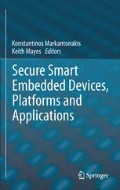Abstract
Hardware Security Modules/(HSMs), also known as Tamper Resistant Security Modules (TRSMs), are devices dedicated to performing cryptographic functions such as data encryption/decryption, certificate management and calculation of specific values such as card verification values (CVVs) or Personal Identification Numbers (PINs). What these devices offer is tamper response, the capability to detect any attacks on their surface and securely delete the sensitive content stored in their memory. Such devices are manufactured to meet specific criteria [e.g. Federal Information Processing Standard (FIPS)] and must be appropriately managed throughout their whole lifecycle. Together with encryption algorithms, cryptographic functions and vendor provided functionalities, they host one or more cryptographic keys that respond to automated or manual commands. Physical security and key management are essential in order to protect the confidentiality and integrity of the keys and these requirements are properly described in various standards. Due to the specific functionality of HSMs, there have been many published attacks via the command interface, which reinforces the need for adequate controls, both physical and logical, around these devices.
Access this chapter
Tax calculation will be finalised at checkout
Purchases are for personal use only
Notes
- 1.
The term “tamper resistant”, in this context includes “tamper-evident” and “tamper-detective” that will often appear in this chapter and which can be used interchangeably, as well as “tamper responsive” which refers to the reaction of the device in a tamper attack.
References
“Payment card industry PIN Security Requirements”, version 1.0, September 2011.
ISO 9564–1, “Financial services - Personal Identification Number (PIN) management and security - Part 1: Basic principles and requirements for PINs in card-based systems”, 2011.
ISO 9797–1, “Information technology - Security techniques - Message Authentication Codes (MACs) - Part 1: Mechanisms using a block cipher”, 2011.
ANSI X9.24-1, “Retail Financial Services Symmetric Key management, Part 1: Using Symmetric Techniques”, 2009.
ISO 13491–1, “Banking - Secure cryptographic devices (retail), Part 1: Concepts, requirements and evaluation methods”, 2007.
ISO 13491–2, “Banking - Secure cryptographic devices (retail), Part 2: Security compliance checklists for devices used in financial transactions”, 2005.
FIPS 140–2, “Security Requirements for Cryptographic Modules”, 2001, with some updates in December 2002.
“Common Criteria for Information Technology Security Evaluation”, see http://www.commoncriteriaportal.org/.
“Payment card industry (PCI) Hardware Security Module (HSM) Security Requirements”, version 1.0, April 2009.
http://csrc.nist.gov/groups/STM/cmvp/documents/140-1/140val-all.htm.
“Payment card industry (PCI): POS PIN Entry Device, Security Requirements”, version 2.1, January 2009.
“PIN Security Program: Auditor’s Guide", version 2, January 2008, see http://usa.visa.com/download/merchants/visa_pin_security_program_auditors_guide.pdf.
ANSI X9.17, “Financial institution key management (wholesale)”, 1985.
ANSI X9 TR-31, “Interoperable Secure Key Exchange Key Block Specification for Symmetric Algorithms”, 2010.
M. Bartolozzo, R. Focardi, M. Centenaro & G. Steel, “Attacking and Fixing PKCS#11 Security Tokens”, ACM Conference on Computer and Communications, Security, 2010, pp. 260–269.
PKCS#11, “Cryptographic Token Interface Standard”, version 2.20, RSA Laboratories, June 2004.
R. Anderson, “Why cryptosystems fail”, Proceedings of the 1993 ACM Conference in Computer and Communications Security, pp. 215–227. See also, http://www.cl.cam.ac.uk/users/rja14/wcf.html.
R. Anderson, “Security Engineering”, (2nd Edition), Wiley, 2008.
J. Clulow, “The Design and Analysis of Cryptographic Application Programming Interfaces for Security Devices”, version 4.0, M.Sc. Thesis at University of Natal, Durban, South Africa, dated 17 January 2003.
Y. Desmedt, F. Hoornaert & J.J. Quisquater, “Several Exhaustive Key Search Machines and DES”, EUROCRYPT 86, 1986, pp 17–19.
R. Clayton & M. Bond, “Experience Using a Low-Cost FPGA Design to Crack DES Keys”, presented at the CHES 2002 Workshop Francisco, 1st August. (http://www.cl.cam.ac.uk/rnc1/descrack/DEScracker.pdf).
M. Bond & P. Zieliński, “Decimalisation Table Attacks for PIN Cracking”, University of Cambridge Computer Laboratory, Technical Report 560, dated February 2003. (http://www.cl.cam.ac.uk/TechReports/UCAM-CL-TR-560.pdf).
R. Anderson & M. Bond, “Protocol Analysis, Composability and Computation”; see http://www.cl.cam.ac.uk/rja14/Papers/bond-anderson.pdf.
Joint USSS/FBI Advisory February 2009, see http://usa.visa.com/download/merchants/20090212-usss_fbi_advisory.pdf.
Author information
Authors and Affiliations
Corresponding author
Editor information
Editors and Affiliations
Rights and permissions
Copyright information
© 2014 Springer Science+Business Media New York
About this chapter
Cite this chapter
Mavrovouniotis, S., Ganley, M. (2014). Hardware Security Modules. In: Markantonakis, K., Mayes, K. (eds) Secure Smart Embedded Devices, Platforms and Applications. Springer, New York, NY. https://doi.org/10.1007/978-1-4614-7915-4_17
Download citation
DOI: https://doi.org/10.1007/978-1-4614-7915-4_17
Published:
Publisher Name: Springer, New York, NY
Print ISBN: 978-1-4614-7914-7
Online ISBN: 978-1-4614-7915-4
eBook Packages: Computer ScienceComputer Science (R0)

